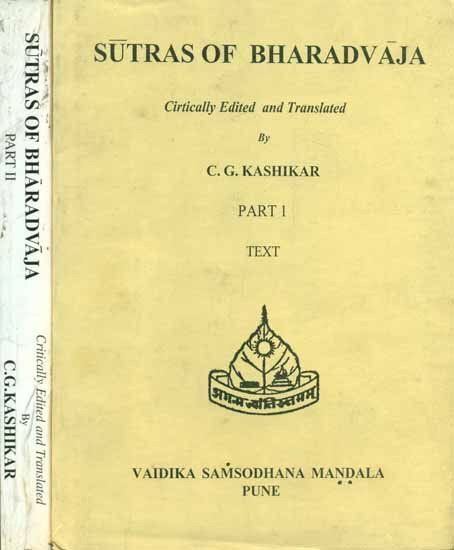Bharadvaja-srauta-sutra
by C. G. Kashikar | 1964 | 166,530 words
The English translation of the Bharadvaja-Srauta-Sutra, representing some of the oldest texts on Hindu rituals and rites of passages, dating to at least the 1st millennium BCE. The term Srautasutra refers to a class of Sanskrit Sutra literature dealing with ceremonies based on the Brahmana divisions of the Veda (Sruti). They include Vedic rituals r...
Praśna 6, Kaṇḍikā 16
1. A modification-sacrifice and the New-moon or the Full-moon sacrifice.
2. In the event of a coincidence of the New-moon or the Full-moon sacrifice with a modification-sacrifice, the New-moon sacrifice or the Full-moon sacrifice predominates.
3. However, such (rites) in the Iṣṭis or Animal-sacrifices predominate as are directly prescribed in the Śruti.
4. The Adhvaryu should prepare a faggot of twenty-three fire-sticks.
5. In this connection this is the general rule: In the case of an increase in the number of the sāmidhenī verses, the number of fire-sticks should grow; in the case of a decrease, it should be normal.
6. The rites up to the arrangement of the utensils should be similar.[1]
7. The Adhvaryu should arrange three winnowing baskets.
8. He should place (that is, arrange) three mortars, and two lower crushing stones.
9. The rites up to the taking up of the winnowing basket should be similar.[2]
10. The Adhvaryu should take three winnowing baskets with the formula, “For work you.”
11. The rites up to the pouring out of the oblation-material should be similar.[3]
12. He should pour out old (paddy) for a cake on eight potsherds to Agni, and then pour out new (paddy) for a cake on eleven potsherds to Indra-Agni.
13. Or (instead of the latter) for a cake on twelve potsherds to Agni-Indra.
14. (Old paddy) for cooked rice to Viśve Devas. It should be cooked in milk.
15. (He should pour out) śyāmāka grains for cooked grains to Soma and (old paddy) for a cake on one potsherd to Dyāvāpṛthivī.[4]
16. Or (for all oblations) he should pour out new (paddy). (In that case, however, he should) not (pour out new paddy) for Agni.[5]
17. The formula prescribed for touching the grains[6] should be repeated at each different procedure.[7]
18. After having poured out the Āgrayaṇa-oblation,[8] the Adhvaryu should offer five oblations of clarified butter with the five verses, “(Obeisance) to the hundred-weaponed, having a hundred powers, having a hundred aids, the overcomer of hostility, Indra, who is capable of leading us for a hundred years without any harm beyond all evils.—O gods, do you all entrust us to that divinity (= Indra) who would lead us without any harm and loss along the four Devayāna paths which stretch differently between the heaven and the earth.—May the summer, winter and spring, autumn and the rainy season be favourable to us. May we enjoy the favour and protection of these seasons through a hundred years.—Do you pay great honour to the Iduvatsara, Parivatsara and Saṃvatsara. In the good will of those who are worthy of sacrifice, may we long be harmless and unsmitten.—O gods, lead us from good to better, May we, O drop, attain thee through thy aid (that is, by partaking of thee). Do thou, wonderworking, enter us. Be propitious and kindly to our children, and to myself.”[9]
19. The rites up to the spreading of the skin of a black antelope should be similar.[10]
20. He should place three mortars on one and the same skin of a black antelope; also two lower crushing stones (on one and the same skin of a black antelope).
21. The rites up to the pouring of the oblation-material within the mortar should be similar.[11]
22. After having poured all the three varieties of the oblation-material within the mortars, he should call out the preparer of the oblation.
23. After all the varieties have been pounded, the Āgnīdhra should strike the upper and the lower crushing stones.
24. He should pour out all the varieties into the winnowing baskets, one after the other, winnow them one after the other, and sift them one after the other.
25. Or as the next best alternative, he should pound (all the varieties) into one and the same mortar one after the other.
26. In this case the formulas prescribed in connection with the rites from the pouring out up to the sifting should be repeated in respect of each variety of grains.
Footnotes and references:
[1]:
I.16.1 ff.
[2]:
I.18.11.
[3]:
I.19.10.
[4]:
Āpastamba-śrauta-sūtra VI.29.11 mentions a view according to which the cake to Dyāvāpṛthivī should precede the cooked grains to Soma.
[5]:
[6]:
I.20.1.
[7]:
That is to say, the Adhvaryu should touch the old paddy with the formula, and then touch new paddy again with that formula.
[9]:
Taittirīya-saṃhitā V.7.2.
[10]:
I.21.2.
[11]:
I.21.5.
